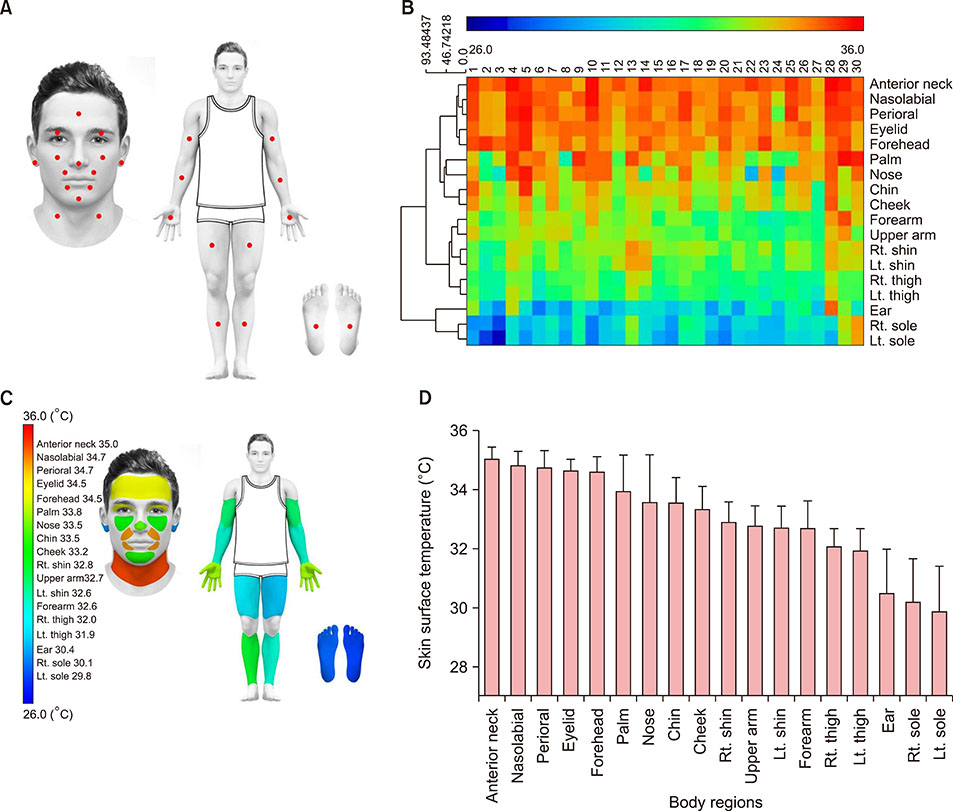Ann Dermatol.
2019 Jun;31(3):349-352. 10.5021/ad.2019.31.3.349.
Regional Variation of Human Skin Surface Temperature
- Affiliations
-
- 1Department of Dermatology, Seoul National University Hospital, Seoul, Korea. ivymed27@snu.ac.kr jhchung@snu.ac.kr
- 2Institute of Human-Environment Interface Biology, Medical Research Center, Seoul National University, Seoul, Korea.
- 3Department of Biomedical Sciences, Seoul National University Graduate School, Seoul, Korea.
- KMID: 2444874
- DOI: http://doi.org/10.5021/ad.2019.31.3.349
Abstract
- No abstract available.
Figure
Reference
-
1. Cho S, Shin MH, Kim YK, Seo JE, Lee YM, Park CH, et al. Effects of infrared radiation and heat on human skin aging in vivo. J Investig Dermatol Symp Proc. 2009; 14:15–19.
Article2. Benedict FG, Miles WR, Johnson A. The temperature of the human skin. Proc Natl Acad Sci U S A. 1919; 5:218–222.
Article3. Hardy JD, DuBois EF, Soderstrom GF. Basal metabolism, radiation, convection and vaporization at temperatures of 22 to 35℃. J Nutr. 1938; 15:477–497.
Article4. Marrakchi S, Maibach HI. Biophysical parameters of skin: map of human face, regional, and age-related differences. Contact Dermatitis. 2007; 57:28–34.
Article5. Mitchell D, Wyndham CH, Atkins AR, Vermeulen AJ, Hofmeyr HS, Strydom NB, et al. Direct measurement of the theramal responses of nude resting men in dry environments. Pflugers Arch. 1968; 303:324–343.
Article6. Yosipovitch G, Xiong GL, Haus E, Sackett-Lundeen L, Ashkenazi I, Maibach HI. Time-dependent variations of the skin barrier function in humans: transepidermal water loss, stratum corneum hydration, skin surface pH, and skin temperature. J Invest Dermatol. 1998; 110:20–23.
Article7. Rubinstein EH, Sessler DI. Skin-surface temperature gradients correlate with fingertip blood flow in humans. Anesthesiology. 1990; 73:541–545.
Article8. Simmons GH, Wong BJ, Holowatz LA, Kenney WL. Changes in the control of skin blood flow with exercise training: where do cutaneous vascular adaptations fit in? Exp Physiol. 2011; 96:822–828.
Article9. Brebner DF, Kerslake DM, Waddell JL. The effect of atmospheric humidity on skin temperature & sweat rates of resting men at two ambient temperatures. J Physiol. 1958; 144:299–306.
Article10. Waller JM, Maibach HI. Age and skin structure and function, a quantitative approach (I): blood flow, pH, thickness, and ultrasound echogenicity. Skin Res Technol. 2005; 11:221–235.
Article
- Full Text Links
- Actions
-
Cited
- CITED
-
- Close
- Share
- Similar articles
-
- Regional Morphological Study on the Development of the Human Embryonic and Fetal periderm
- Comparison of the Diagnostic Validity of Real and Absolute Skin Temperature Differences for Complex Regional Pain Syndrome
- Regional Variation in the Expression of Epidermolysis Bullosa Acquisita Antigen
- Clinical Application of Digital Infrared Thermographic Imaging for the Prediction of Foot Ulcer Development in Diabetic Patients
- The Effect of Cold Air Application for the Intraarticular and Skin Temperature Changes of Knees


